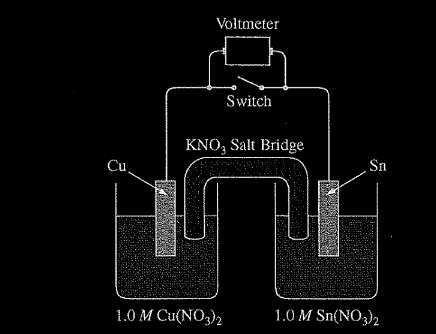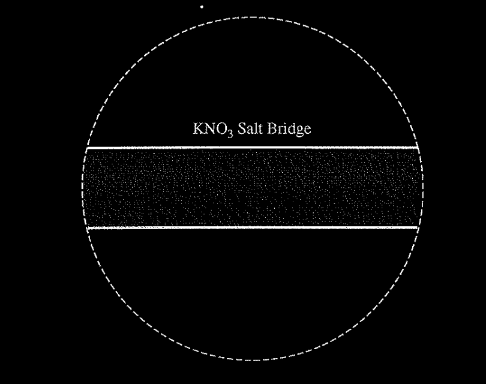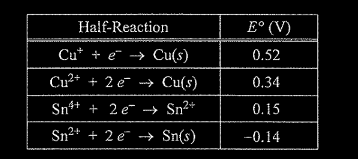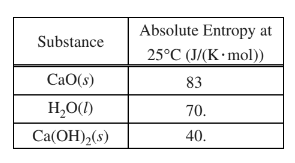Question

A student is given a standard galvanic cell, represented above, that has a Cu electrode and a Sn electrode. As current flows through the cell, the student determines that the Cu electrode increases in mass and the Sn electrode decreases in mass.
(a) Identify the electrode at which oxidation is occurring. Explain your reasoning based on the student’s observations.
(b) As the mass of the Sn electrode decreases, where does the mass go?
(c) In the expanded view of the center portion of the salt bridge shown in the diagram below, draw and label a particle view of what occurs in the salt bridge as the cell begins to operate. Omit solvent molecules and use arrows to show the movement of particles.

d) A nonstandard cell is made by replacing the 1.0 M solutions of Cu\((NO_3)_2\) and Sn\((NO_3)_2\) in the standard cell with 0.50 M solutions of Cu(NO3)2 and Sn\((NO_{3})_{2}\). The volumes of solutions in the nonstandard cell are identical to those in the standard cell.
(i) Is the cell potential of the nonstandard cell greater than, less than, or equal to the cell potential of the standard cell? Justify your answer.
(ii) Both the standard and nonstandard cells can be used to power an electronic device. Would the nonstandard cell power the device for the same time, a longer time, or a shorter time as compared with the standard cell? Justify your answer.
(e) In another experiment, the student places a new Sn electrode into a fresh solution of 1.0 M\( Cu(NO_{3})_{2}\) ·

(i) Using information from the table above, write a net-ionic equation for the reaction between the Sn electrode and the Cu\((NO_3)_2\) solution that would be thermodynamically favorable. Justify that the reaction is thermodynamically favorable.
(ii) Calculate the value of \(\Delta G\) for the reaction. Include units with your answer.
▶️Answer/Explanation
(a) Since the Sn electrode is losing mass, Sn atoms must be forming \(Sn^{2+}\)(aq). This process is oxidation. OR because the cell operates, E° must be positive and, based on the E° values from the table, it must be Sn that is oxidized.
(b) The atoms on the Sn electrode are going into the solution as \(Sn^{2+}\) ions.
(c) The response should show at least one \(K^+\) ion moving toward the Cu compartment on the left and at least one \(NO_{3}^-\) ion moving in the opposite direction.
d(i) It is the same. In the cell reaction \(Q= \frac{[Sn^{2+}]}{ [Cu^{2+}]}\) , and the concentrations of \(Sn^{2+}\) and \(Cu^{2+}\) are equal to each other in both cases.
d(ii) The nonstandard cell would power the device for a shorter time because the supply of \(Cu^{2+}\) ions will be exhausted more quickly. OR The nonstandard cell would power the device for a shorter time because the reaction will reach E=0 more quickly.
e (i) \(Cu^{2+}(aq) + Sn(s) → Cu(s) + Sn^{2+}\)(aq) E° is positive \((0.34 V + 0.14 V = 0.48 V)\), therefore the reaction is thermodynamically favorable. OR The cell observations from earlier parts of the question are evidence that the Sn is oxidized and Cu is reduced, therefore E° must be positive.
e.(ii) \(\Delta G^0=-nFE^0\)
\(\Delta G^0=-\frac{2 mol e^-}{mol_{rxn}}\times \frac{96,485}{mol e^-}\times \frac{0.48}{c}=-93,000 J/mol_{rxn}\)
Question
\(CaO(s)+H_{2}O(l)\rightarrow Ca(OH)_{2}(s) \Delta H^{\circ}_{rxn}=-63.7kj/mol_{rxn}\)
Calcium oxide, CaO(s), has been proposed as a substance that can be used to heat water quickly for portable heating packs or for cooking. When placed in water, CaO(s) reacts as shown by the equation above.
(a) A student wants to design a heating pad that could heat a 150.0 g sample of water from \(25.0^{\circ}C to 60.0^{\circ}C. 4.18J/(g.^{\circ}C).) \)
(i) Calculate the amount of heat, in joules, that the water must absorb for its temperature to change by this amount. (Assume that the specific heat capacity of the water is \(4.18 J/(g.^{\circ}C)\)
(ii) Calculate the minimum mass of CaO(s) that the student would need to use in order to cause this temperature change.
(b) The student hypothesizes that the design of the heating pad could be changed to enable it to heat 150.0 g of water from \(25.0^{\circ}C to 90.0^{\circ}C\) by using a greater mass of CaO(s).
(i) Use the data in the table below to determine the standard entropy change, \(\Delta S^{\circ}_{rxn}, in J/(K.mol_{rxn}) \Delta S^{\circ}_{rxn} and \Delta H^{\circ}_{rxn} \)for the reaction.

(ii) Is the reaction thermodynamically favorable at 90.0°C? Justify your answer with a calculation. (Assume that both \(\Delta S^{\circ}_{rxn}\) and \( \Delta H^{\circ}_{rxn}\) are constant between 25.0°C and 90.0°C.) The student learns that the \(Ca(OH)_2\) produced from the reaction is relatively insoluble and that it dissolves in water according to the equation below.
\(Ca(OH)_{2}(s)\rightarrow Ca^{2+}(aq)+2OH^{-}(aq)\)
(c) The student prepares a saturated solution of Ca(OH)2 and determines that the \([Ca^{2+}] \)is 0.011 M. Calculate
the value of\( K_{sp}\) for \(Ca(OH)_{2}\)
The student wishes to significantly increase the molar solubility of the. \(Ca(OH)_{2}(s)\) and has access to the following substances.
15 mL of distilled water 15 mL of 1.0 M KOH(aq)
15 mL of 1.0 M\( CaCl_2\)(aq) 15 mL of 1.0 M HCl(aq)
(d) Which substance, when added to the \(Ca(OH)_2\) mixture, would increase the molar solubility most significantly? Justify your choice based on concepts of chemical equilibrium, such as Le Châtelier’s principle.
▶️Answer/Explanation
a(i)\(q=mc\Delta T = 150.0 g x 4.18 J/(g °C) x (60.0°C -25.0°C) = 2.19 x 104 J\)
a(ii)

b(i) \(\Delta S°_rxn \) = ∑S° products – ∑S° reactants
= \(40. J/(K.mol) – [83 J/(K.mol) + 70. J/(K.mol)]\)
= \(-113 J/(K.mol_{rxn})\)
b(ii) Yes, because \(\Delta G° is negative. \Delta G° = \Delta H° – T \Delta S° =-63.7 kJ/mol_{rxn} K (-113 J/(K.mol_{rxn})) ×\frac{1kj}{1000j} = -22.7 kJ/mol_{rxn}\)
(c) \( [OH^-] = 2 × [Ca^2+] = 2 (0.011 M) = 0.022 \)\(M K_sp=[Ca^2+] [OH^-]^2 = (0.011)(0.022)^2 = 5.3 × 10^-6\)
(d) HCl
The \(H^+\) from the HCl reacts with \(OH^−\), decreasing \([OH^−]\). The loss of\( OH^−\) results in non-equilibrium conditions in the\( Ca(OH)_2\) dissolution. More\( Ca(OH)_2\) must dissolve to increase\( [OH^{−}]\), increasing the molar solubility as Q approaches K and the system returns to equilibrium.
Question
\(3Ag(s)+4HNO_{3}(aq)\rightarrow 3AgNO_{3}(aq)+NO(g)+2H_{2}O(l)\)
A student investigates the reaction between Ag(s) and \(HNO_3\)(aq) represented by the equation above.
(a) Predict the sign of the entropy change, ΔS°, for the reaction. Justify your answer.
(b) Use the information in the table below to calculate the value of \(\Delta H^{\circ}_{rxn}\), the standard enthalpy change for the reaction, in\( kJ/mol_{rxn}\) .

(c) Based on your answers to parts (a) and (b), is the reaction more likely to be thermodynamically favorable at 25°C, or at 95°C? Justify your answer.
(d) The student runs the reaction using a 3 to 4 mole ratio of Ag(s) to\( HNO_3\)(aq). Suggest a method the student can use to isolate solid \(AgNO_3 \)from the other products of the reaction.
▶️Answer/Explanation
(a) The entropy change is positive because the reaction has one mole of gas in the products and none in the reactants.
(b)\( \Delta H^{\circ}_{rxn} = 3(-101) + 90. +2(-286) -4(-207)
= 43 kJ/molrxn\)
(c) \(\Delta G^{\circ}=\Delta H^{\circ}-T\Delta S^{\circ}\) The reaction is more likely to be favorable at \(95G^{\circ}\). At the higher temperature, the term\( T\Delta S^{\circ}\) is larger and positive; thus, when subtracted from \(\Delta H^{\circ}\), the value of \(\Delta G^{\circ} \) is more likely to be negative.
(d) The student can evaporate the water, leaving behind solid silver nitrate.
